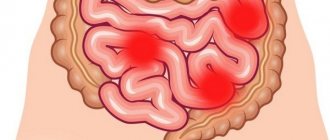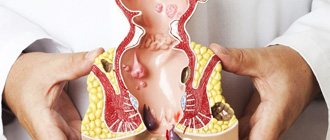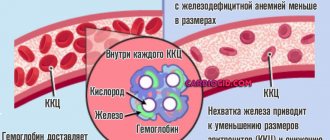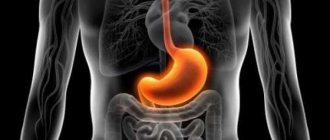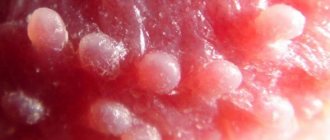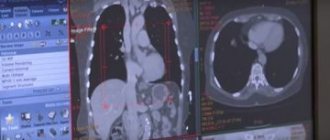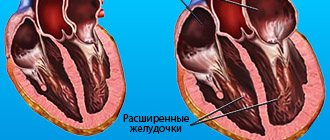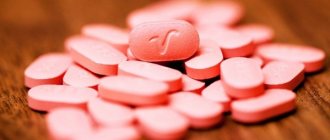With the help of bowel movements, harmful substances and food that has not been digested are removed from the human body. During normal functioning of the body, a person goes to the toilet once or twice a day.
Sometimes people experience diarrhea and the stool changes in consistency and color. When greenish stool is observed in an adult, the reasons for this are very different and all this may indicate some abnormalities in the body.
Why does green diarrhea appear?
Greenish stool does not always mean that there are abnormalities in the functioning of the body; the cause may be the use of any food or medication.
The reasons for the formation of loose stools with a green tint can be a variety of factors, such as:
- the appearance of infections in the intestines;
- dysbacteriosis;
- eating any food;
- taking medications;
- stomach diseases.
The cause of occurrence is determined based on:
- from the existing symptoms;
- the patient's condition;
- the results obtained after taking the tests;
- additional examination if necessary.
Diagnostic features
Since various pathologies can cause loose green stools, the doctor must make the correct diagnosis before prescribing a course of therapy. To do this, he prescribes a number of diagnostic studies.
Diagnostics
Diagnostics consists of the following procedures:
- visual examination of the patient;
- Ultrasound of the pelvic organs;
- blood test for the presence of hemoglobin, red blood cells, platelets and leukocytes;
- general and bacteriological analysis of stool.
Laboratory analysis
Based on the results obtained, the doctor can make an accurate diagnosis. Only after this is the appropriate course of therapy prescribed. As a rule, it all comes down to changing your diet or taking vitamin supplements. But in rare cases, a more serious approach is required.
https://youtu.be/BJoL48f9-RI
Symptoms that may accompany the condition
The most common cause is an intestinal infection that enters the body through the mouth, water, food or hands.
In addition to the fact that greenish stool appears, a person may be bothered by:
- vomiting and fever;
- the appearance of pain in the abdominal area;
- dizziness;
- lack of appetite.
An infection that enters the digestive system can cause various inflammatory ailments:
- During intestinal infections, there are many white blood cells present in the stool, which is why it takes on a green tint.
- In rare cases, a person develops dysbiosis; it appears due to antibiotics, allergies, improper food intake, and a weakened immune system.
If a person has completed a course of taking antibacterial drugs, then a change occurs in his intestinal microflora. To prevent this from happening, it is necessary to use probiotics during treatment with these medications to maintain intestinal microflora.
If green stool appears as a result of eating certain foods, large amounts of sweet soda, vegetables and herbs, then this does not pose a threat to the body.
Traditional methods
Home remedies can only be used if the greenish color of the stool is due to a malnutrition or intestinal disorder. They are used for the first 3–5 days; if during this period the symptoms do not disappear, and the condition worsens with the appearance of vomiting and fever, you should immediately consult a doctor.
A good remedy is herbal decoctions of chamomile, rose hips, oregano or mint. Rice water, which is taken several times a day before meals, has a beneficial effect on the digestive organs.
To combat diarrhea, patients use oatmeal decoction. It is prepared from 4 tablespoons of oatmeal and 500 ml of water. Boil the cereal and let it brew for an hour. Drink 1 glass per day, dividing the intake into two times - in the morning on an empty stomach, in the evening before bed.
It is allowed to give the patient activated carbon or other sorbents that help remove toxins from the body.
Why does an adult have dark green diarrhea?
Dark green diarrhea in an adult occurs for the following reasons:
- The most dangerous reason why stool turns dark green is bleeding in the stomach and intestines.
- The color of the stool becomes dark due to the oxidation of iron, which is contained in the human blood.
- If the iron is not completely oxidized, then an adult will produce greenish feces of a dark shade.
Poor functioning of the gastrointestinal tract or blood diseases may also be the cause, for example:
- For some reason, the liver may begin to produce large amounts of bilirubin, which, when it enters the stomach, turns the stool a dark shade.
- In addition, the cause may be improper functioning of the pancreas or the production of a small amount of enzymes.
Yellow-green diarrhea in an adult
The causes of yellow-green diarrhea may be:
- Infections in the intestines that enter the body through the oral cavity. In this case, the stool takes on a yellow-green or yellow tint. Body temperature may rise, nausea and general weakness may appear. Dehydration, muscle pain, and loss of appetite may also occur.
- Similar symptoms accompany dysbacteriosis, only with this disease, the stool becomes liquid and contains mucus.
Diarrhea with green water in an adult
In some cases, the cause of green loose stools is the action of the person himself. Often this negative phenomenon is associated with insufficient hand hygiene.
Water diarrhea can also occur for the following reasons:
- allergic reactions to food;
- drinking bad water or products that are incompatible with each other;
- dirty vegetables or fruits;
- medications;
- poisoning;
- state of pregnancy.
Diarrhea may also occur:
- as a result of intestinal infections;
- improper functioning of the digestive system;
- food intoxication;
- other problems in the gastrointestinal tract.
In addition to diarrhea, you may experience:
- vomit;
- nausea;
- temperature increase;
- abdominal pain;
- weakness.
The color of stool changes due to the large number of leukocytes.
When medical attention is needed
What should be done if the usual color of the stool is not restored? Of course, visit your local doctor without waiting for the body to cope on its own. What to tell the doctor? You need to say it like it is: “I don’t go to the toilet the way I always do, green, and I’m worried about my health.”
A visit to the clinic should not be postponed if changes in the color of excrement are accompanied by changes in blood pressure, lethargy, poor sleep, indigestion, fever, vomiting, and pain.
An extremely dangerous situation is when black-green feces are combined with severe weakness, chills, sweating, and vomiting with black masses. These are symptoms of gastrointestinal bleeding. The patient needs to call the ambulance service, as the pathology can lead to serious consequences and even death.
The appearance of unusually colored stool is not always a sign of illness. Green shit often only speaks of errors in the diet. But this is a reason to carefully monitor your body so as not to miss the development of a serious pathology.
Gastroenterologist, PhD. Graduated from the First Moscow State Medical University named after. I. M. Sechenov in 2010. Place of work - Medical
Green diarrhea with blood
Green diarrhea with blood can signal serious complications; if it appears accompanied by other symptoms, you should seek help from a doctor as soon as possible.
Causes of green diarrhea with blood:
- Bloody diarrhea can occur due to internal hemorrhoids.
- In addition to diarrhea, a person may experience pain and burning in the anus.
- In addition to hemorrhoids, the cause may be a disease caused by an infection.
- If the color changes to darker, this indicates problems with the intestines.
- Bloody diarrhea can also occur due to bleeding in the intestines or stomach.
Why does an adult have green diarrhea and vomiting?
Causes of green diarrhea and vomiting:
- When diarrhea appears along with vomiting, you need to consult a doctor as soon as possible.
- This may be intoxication of the body or an intestinal infection.
- If measures are not taken to eliminate the causes, the condition may worsen significantly.
Signs of poisoning that have occurred appear a couple of hours after consuming the source of poisoning.
A person experiences:
- frequent vomiting;
- the temperature begins to rise;
- pain appears in the abdominal area;
- Diarrhea occurs a little later.
In this case, you need to consult a doctor as soon as possible.
What determines the color of stool?
Normally, every adult has a bowel movement every 1-2 days. The color of the discharge has different shades of brown, but sometimes slight deviations may appear without harm to health. What can cause greenish color in excrement:
- brightly colored vegetables and fruits;
- artificial colors;
- medications;
- foreign impurities (mucus, bile, blood, etc.).
The first three points are not cause for concern; these are the main causes without diarrhea and other signs. The deviation in the form of green feces disappears in a couple of days, if not caused by dangerous diseases.
If changes in the color of feces are accompanied by pain, weakness, nausea, etc., you need to go to the doctor. Green stool with mucus or other foreign matter is also a reason for examination.
If green diarrhea appears, what should you do?
If green diarrhea appears, you need to do the following:
- If diarrhea appears, a person immediately thinks about treating the disease.
- In this case, the person cannot be allowed to become dehydrated in the body.
- It is necessary to find out as soon as possible why an adult has greenish stool and how to treat it; for this you need to consult a doctor.
You cannot make independent decisions to treat the disease; this can only worsen the situation. At the clinic, the patient will be sent for all the necessary tests and examinations, and based on the results obtained, the doctor will prescribe treatment.
Use of antibiotics
For diarrhea, the doctor may prescribe medications (antimicrobials), this could be:
- Amoxicillin;
- Metronidazole;
- Tetracycline;
- Gastrolit;
- Regidron.
Taking such drugs usually does not exceed 7 days, this time is enough to correct the body’s condition.
Cleansing the body with medications
In addition to antibiotics, the doctor will prescribe the patient to take sorbents.
The most effective drugs are:
- Smecta, Dioctite, Diosmectite, Neosmectin;
- Enterosgel;
- Polysorb.
These drugs help remove toxins from the body and create favorable conditions for the development of microorganisms beneficial to the body. When taking these medications, the formation of gases and fermentation in the intestines is significantly reduced. During treatment with these drugs, a person must drink as much fluid as possible.
Restoration of intestinal flora
If the cause of diarrhea is dysbacteriosis, the doctor will prescribe a course of bacteria that are beneficial for the intestinal microflora:
- Linux;
- Acipol;
- Baktisubtil;
- Normoflorin.
Usually the doctor prescribes a course lasting one month; to improve the condition, you can prepare yoghurts at home with the addition of bacteria.
Taking enzymes
In case of green stool due to a lack of enzymes, the course treatment includes enzymes such as:
- Creon;
- Pancreatin.
It may happen that the patient has to take these medications throughout his life, only in this case his stool and general well-being will normalize.
Surgical intervention
If the cause of diarrhea is internal bleeding , then the patient must undergo surgery.
The method of surgical intervention depends entirely on the nature and area of bleeding. If the operation is postponed or not performed, then quite serious consequences are possible. During surgery, general anesthesia is provided, and after the operation the person is incapacitated for some time.
Diet
The medical worker, in addition to drug treatment, prescribes special dietary nutrition to the patient.
A person must refuse:
- from bakery products;
- sweet food;
- carbonated and alcoholic drinks;
- fruits, vegetables and herbs;
- If you have pancreatic diseases, then you need to exclude fatty, fried, smoked and spicy foods from your diet.
It is advisable to use:
- vegetable-based broths and soups;
- During periods of exacerbation of diarrhea, you need to eat rice porridge;
- bananas in moderation; Read here what happens to a child’s feces after eating a banana.
- products of liquid and jelly-like consistency;
- If you have dysbiosis, you need to drink fermented milk drinks regularly.
In addition to diet, you need to drink as much water as possible to replenish lost fluid in order to prevent dehydration.
Treatment with drugs
For serious manifestations of digestive tract disorders, it is not recommended to self-medicate. In some cases, only hospital treatment is necessary, in special situations - surgical intervention.
Before calling a doctor and if there is a clear picture of poisoning or diet violations, it is permissible to use some remedies yourself.
As a sorbent
Activated carbon:
- released in tab. and powders;
- used for diarrhea as a means of detoxification, removes rotting products and toxins;
- taken 1 tablet. per 10 kg of body weight or 20 g of powder – 1 dose;
- washed down with a large volume of water.
Polysorb:
- manufactured in the form of powder for suspension;
- removes toxins and allergens from the body;
- For children under 7 years of age, the recommended dose is 150 mg per 10 kg of weight, for adults – 12 g;
- Duration of use is from 3 days to a week.
Smecta:
- is a natural preparation, a combination of aluminum and magnesium silicates;
- Available in powder form for suspension;
- forms a protective layer on the gastric mucosa, preventing exposure to toxins and acids;
- daily intake for infants - 1 sachet, from 2 years - 2 sachets, for adults - 3 sachets during the day;
- Duration of treatment – no more than 3 days.
Atoxyl:
- Available in powders;
- active ingredient silicon dioxide;
- used for intestinal diseases with diarrhea, removes toxic, poisonous substances, products of decay and the activity of pathogenic bacteria;
- taken in the form of a suspension 1 hour before taking other medications. 1 sachet of the drug dissolves in 50 g of water;
- The daily norm for persons over 7 years old is 12 g in 2-3 doses.
To restore microflora (probiotics)
Hilak forte:
- release form - drops;
- improves food digestibility, localizes the spread of pathogenic environments;
- the product is dissolved in water as follows: age 1-2 years - 15-30 drops 3 times a day before or during meals, adults - 20-40 drops;
- Duration of treatment is at least 1 week.
Bificol:
- powder for suspension is contained in ampoules or bottles for 5 doses;
- drink half an hour before meals;
- has an antimicrobial effect and also normalizes the intestinal microflora;
- the dose of bificol and the need for its use is determined by the doctor (from 1 to 5 doses 2 times / day for 5 days to 2 weeks).
Linux:
- packaged in capsules of 1g;
- additional varieties: Linex Forte and Linex Baby (in sachet);
- stops diarrhea, thereby normalizing conditions for the restoration of microflora;
- Children under 2 years of age are recommended to take 1 capsule 3 times a day, at older ages - 2 capsules. with the same frequency;
Bifidumbacterin:
- powder, packaged in 5 doses;
- inhibits the vital activity of pathogenic bacteria, thereby normalizing the functioning of the gastrointestinal tract;
- newborns are prescribed 2 servings 3 times a day, from 6 months to 1 year - 3 servings 3 times a day, other age groups - 1 package 3 times a day;
- course – no more than 1.5 weeks.
To stop vomiting symptoms and diarrhea
Imodium:
- contained in capsules;
- the main substance is loperamide, which selectively blocks opioid receptors;
- there are a number of contraindications;
- taken after consultation with a doctor. Most often this is for adults at a time - 2 tablets. (no more than 8 per day), for children over 6 years old – 1 tablet. (no more than 3 per day).
Enterobene:
- tab. symptomatic antidiarrheal action;
- prescribed for children over 8 years of age, 1 tablet. no more than 4 tablets per day, from 18 years old - 2 tablets, maximum 8 tablets. per day;
- when stool normalizes or is absent for more than half a day, enterobene stops drinking;
- There are side effects that can be treated with an antidote (naloxone).
Loperamide:
- Available in tablets, dissolving in water, capsules, syrup;
- slows down intestinal motility, reducing the number of urges to defecate;
- For children under 5 years of age, syrup is recommended - 1 mg per 10 kg of weight 3 times a day, for school age - 2 mg according to the same regimen, for adults - 4 mg;
- duration of effect on nerve endings in the intestinal mucosa – 5 hours;
- used in complex treatment.
Cerucal:
- synthetic drug for injection and oral administration;
- the main substance is metoclopramide hydrochloride, which normalizes gastrointestinal motility and acts as an antiemetic;
- administered (IV or IM) to persons over 14 years of age - 1 amp. 3 r/day. Children from 3 to 14 years old - maximum per day - 0.5 mg per kg of weight. It is recommended for adults to take cerucal in tablets 3 times a day (1 tablet), for adolescents - 2 times;
- the medicine is taken half an hour before meals with plenty of water;
- there are a number of contraindications.
